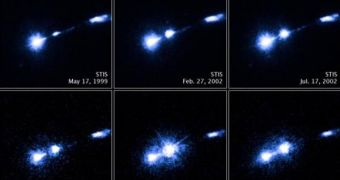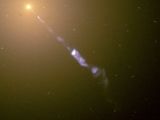The Messier 87 galaxy, known among astronomers as M87, Virgo A, or NGC 4486, is an elliptical galaxy of massive proportions, located in the Virgo Cluster, some 55 million light-years away from Earth. For more than seven years, the Hubble Space Telescope has been following the evolution of the supermassive black hole at Virgo A's core, which is dead in the middle of a very active galactic nucleus. Previous observations have determined that M87's center emits a jet of gas more than 5000 light-years in length, but new photos show a massive intensification in its emission levels.
“I did not expect the jet in M87 or any other jet powered by accretion onto a black hole to increase in brightness in the way that this jet does. It grew 90 times brighter than normal. But the question is, does this happen to every single jet or active nucleus, or are we seeing some odd behavior from M87?” the leader of the new Hubble study, McMaster University Astronomer Juan Madrid, asked, as quoted by Space. The bright blob has been dubbed HST-1, and the Canadian researcher said that its brightness outshone that of the galactic core itself.
“By watching the outburst over several years, I was able to follow the brightness and see the evolution of the flare over time. We are lucky to have telescopes like Hubble and Chandra, because without them we would see the increase in brightness in the core of M87, but we would not know where it was coming from. We hope the observations will yield some theories that will give us some good explanations as to the mechanism that is causing the flaring. Astronomers would like to know if this is an intrinsic instability of the jet when it plows its way out of the galaxy, or if it is something else,” the expert also added.
New studies have revealed that the HST-1 formation is currently some 214 light-years away from the black hole, but that knowledge does little to increase the level of knowledge astronomers have of this type of phenomena. They are aware of the fact that all black holes spew out material on an axis perpendicular to the formation's disk, but how these jets form and why is still a matter hotly debated among astronomers.
In surveys conducted between 1999 and 2005, Hubble mission scientists noticed that the jets continuously grew brighter, until they got to be about 90 times more so than at the beginning of the observations. After 2005, they began to gradually fade in intensity, but they regained strength starting November 2006. For the studies, Hubble's ultraviolet images were combined with Chandra X-ray Observatory's X-ray photos, as well as with radio-wavelength readings from other observatories.

 14 DAY TRIAL //
14 DAY TRIAL // 
